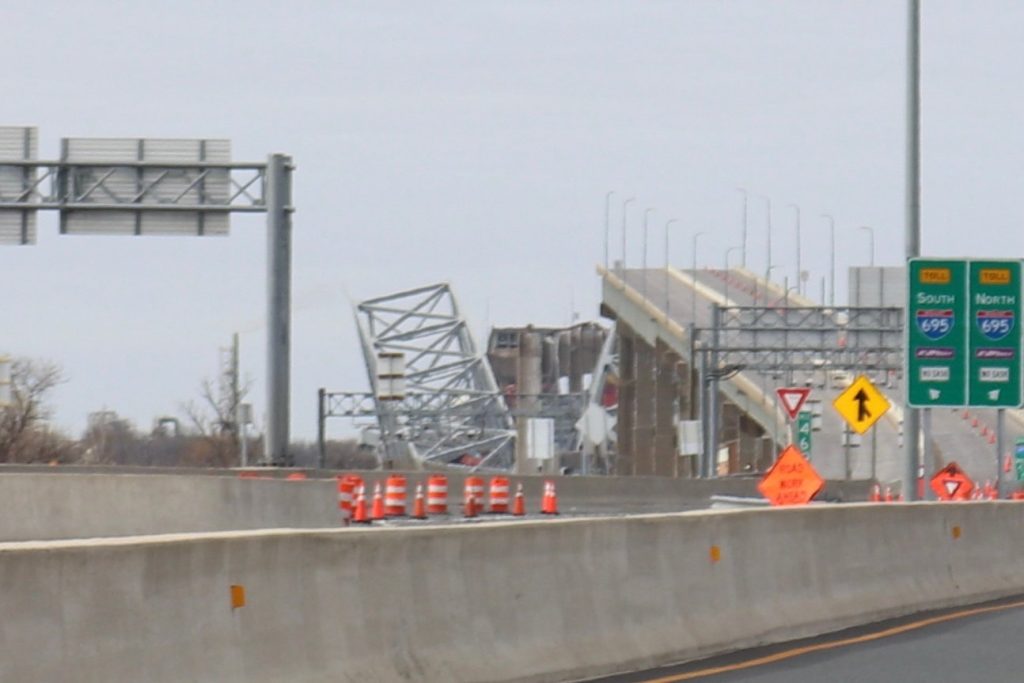Francis Scott Key Bridge following collapse
Guest editorial by Jim Nelles:
The video footage of the Singaporean-flagged cargo vessel, the Dali, crashing into the Francis Scott Key Bridge in Baltimore is truly horrifying.
Video footage shows the ship’s lights flickering on and off, indicating it lost power shortly before crashing into the bridge’s stanchion. The video also shows black smoke coming from the ship’s exhaust vents, indicating that the crew was trying to restart diesel engines.
Unfortunately, eight workers were performing construction on the bridge at the time of collapse, only two of whom were rescued. Given the temperatures of the Patapsco River, they must be presumed deceased. In addition, a number of cars were on the bridge when it collapsed.
The ship issued a mayday prior to hitting the bridge, which allowed Maryland Transportation authorities to stop traffic on the bridge, saving countless lives.
However, this begs the question, why did the ship not drop anchor upon losing power, as is standard protocol when a ship is in what is called restricted maneuvering conditions. Upon losing power, the ship’s personnel should have dropped anchor.
Regardless of the ship failing to follow protocol, the disaster should serve as a warning about the security of our ports.
The port of Baltimore is now closed. The port handled 52.3 million tons of international cargo, worth approximately $80.8 billion in 2023. The port supports more than “15,000 direct jobs and more than 139,000 indirect jobs, generating more than $3 billion in total personal income.”
The port handled a record amount of foreign cargo last year, and it was the 17th biggest port in the nation overall in 2021, ranked by total tons, according to the Bureau of Transportation Statistics.
The port was the largest importer of trucks and light vehicles in 2023, with approximately 750,000 cars and light trucks entering the port in 2023.
Beyond that, an estimated 12.4 million vehicles cross the Francis Scott Key Bridge every year, nearly 34,000 per day.
The economic impact of this bridge collapse is beyond measure.
As of Tuesday morning, more than 40 ships are stuck inside of the harbor.
Imagine a similar accident in New York, collapsing the Verrazano Narrows Bridge, blocking the entrance to the ports of New York and New Jersey, which moved nearly 9.5 million containers in 2022.
In addition, Synergy Marine Group, the company that operates the vessel, is a huge fan of DEI, claiming that they “realize that the benefits of diversity are best achieved by fostering greater inclusion and belonging.
Perhaps they should be focusing on navigation, and not Diversity. To paraphrase Elon Musk’s interview with Don Lemon, DEI can lead to DIE.
So what is to be done?
First, the nation’s Secretary of Transportation, who has been missing in action, needs to ensure that all ships entering American ports are properly manned and that they follow standard protocols when entering our waters.
Second, protocols need to be formalized into law, not just standard practice.
Last, the U.S. Coast Guard must ensure the safety of our ports, even at the risk of impacting commerce. This disaster has become a blueprint for terrorists looking to destroy our nation’s economy.
Jim Nelles is a supply chain consultant based and political analyst in Chicago, IL. He has served as a Chief Procurement Officer, Chief Supply Chain Officer, and a Chief Operations Officer for multiple companies. He has a BA from Northwestern University in Economics and French as well as a Masters in Management from the JL Kellogg Graduate School of Business.
The post OP-ED: The Baltimore Bridge Disaster By Supply Chain Expert and Navy Veteran Jim Nelles appeared first on The Gateway Pundit.







